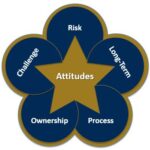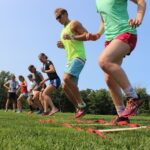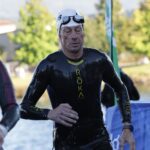I’m fortunate to be working with a handful of ski racers from several countries preparing to compete in the 2018 Winter Olympic Games in Pyeongchang, South Korea this month. It is an honor and a privilege to work with such remarkable athletes and to do my part in helping them to achieve their ski racing dreams and goals. At the same time, as much as they may learn from me, I am also fortunate to learn so much from them.
In the months leading up to Pyeongchang, these athletes and I have explored many different approaches on how best to manage the psychological, emotional, physical, social, and logistical challenges of such a big athletic event. One big takeaway from these discussions is that there is no single way to approach a phenomenon such as the Olympic Games. For each of these athletes, we developed a strategy that best fit their personalities, experience, strengths, and weaknesses, all with the goal that when they slide into the starting gate, they will be as prepared as they can be to ski their fastest.
With the Olympics less than a week away, I realized that the insights that these athletes had, the strategies they developed, and the plans they created aren’t unique to preparing some of the world’s best ski racers for perhaps the biggest races of their lives. Rather, young racers, who are getting ready for their personal version of the Olympics, can learn a lot from them as well. Whether your “Olympics” this season is a local, state, or regional championships, Junior Nationals, Topolino or Whistler, U.S. Nationals, or what-have-you, you also want to be prepared to ski your fastest on race day.
 Continuing to improve your technique and tactics and sticking with that winter physical conditioning maintenance program will have helped. But whether you succeed or fail to achieve your goals at these all-important races ultimately depends on what happens between your ears as these events near. Developing the right approach for you is your key to skiing your best.
Continuing to improve your technique and tactics and sticking with that winter physical conditioning maintenance program will have helped. But whether you succeed or fail to achieve your goals at these all-important races ultimately depends on what happens between your ears as these events near. Developing the right approach for you is your key to skiing your best.
General Approaches
KISS principle. Ski racing is a pretty complicated sport. There are many contributors to ski racing success including physical, technical, tactical, equipment, mental, weather, conditions, and team, just to name a few. Additionally, there are many things that can go wrong leading up to, preparing for, and during a big race like the Olympics. There are usually more people involved, more things to do as an athlete, more responsibilities to more people, and a lot more distractions. All of these complications can lead to more complications inside your head including overthinking, doubt, worry, expectations, pressure, and stress. And this tsunami of complications can overwhelm you and lead to a disappointing performance.
The KISS principle is my antidote to all of these complications. Most people know the KISS principle as “Keep it Simple, Stupid”, but I prefer to define it as “Keep it Simple, Smart.” If you’re smart, you’ll keep your lead-up to and participation in the big race as simple as possible.
Identify those few essential things that have the most impact on your performance and focus on them. Also, identify those things that are not important to your performances and do your best to ignore them. And remind yourself why you’re there. It’s easy to get caught up in the hoopla of a big event, whether the attention you’re getting (e.g., from family and friends, fans, or the media), the activities related to the event (e.g., banquets, press conferences), and the talk about winning. If you go to this “dark side”, think about why you’re really there: for the fun, for the excitement, for the opportunity to show yourself how good you can be, for the satisfaction of giving your best effort, regardless of the outcome.
Dance with the one who brung ya. Yes, I realize that this phrase is bad English, but it conveys a very important message. Too often, when racers are preparing for a big event, they feel that they need to do something different, something special, that they need to “raise their game” because the race is so important. In fact, that is the worst thing you can do. To the contrary, you want to keep doing exactly what you did to get there. Dancing with the one who brung ya means sticking with the fundamentals of what has worked in the past. You should maintain good eating and sleeping habits. You should continue your usual conditioning program, though dialing it back to ensure you stay rested. You should keep to the training and race routines that have gotten you prepared in the past.
Specific Strategies
In addition to establishing a general approach to big races, the Olympic athletes I work with identified some important specific strategies that they are using as their races at the Games near and will deploy on race day.
Be happy. It seems a little cliché, but just doing things that make them happy was one of the most common suggestions among these athletes. We identified particular people and experiences that generated positive emotions (perhaps the best antidote to doubt, worry, stress, and pressure). Ideas included listening to music they love, watching fun movies, reading interesting books, spending time with friends and family, and meeting athletes from other countries.
Lots of imagery. As you probably know by now, I believe that mental imagery is the most powerful mental tool there is for preparing for a big event like the Olympics. With big races approaching, you can imagine yourself racing fast over and over and over again. There are several benefits to using imagery for upcoming races. First, it instills the image and feeling of fast skiing which will boost your confidence. Second, it focuses you on what you need to do to ski fast. Third, it primes your mind and body for skiing your fastest. The bottom-line value of imagery is that when you get to the big race, you’ve already skied it many times—in your mind–so, in the actual race, you just allow those images and feelings come out for fast skiing.
Stick with your routines. For big races, such as the Olympics, routines are especially important. In a setting that may be new, different, and out of your control, routines are familiar, predictable, and controllable. Because of this, routines provide you with confidence and comfort.
Choose a Road
What we can learn from this is that there is no one ideal approach. You must look at how you have handled big races in the past. If you skied well using one approach, then stick with it (“If it ain’t broke, don’t fix it!”). But if it didn’t work before, don’t expect it to work next time. In this case, you will want to do something different.
I can’t guarantee that these approaches and strategies will result in an Olympic medal for the athletes I’m working with who are going to South Korea. But I can say with confidence that putting these ideas into action will certainly increase their chances of achieving their Olympic goals. And the same holds true for your “Olympics” that lie ahead for you this season.
Want to make get your mind in the best shape of your ski racing life? Or are you struggling so far this season? Take a look at my online mental training courses for ski racers, coaches, and parents or contact me if I can help.







